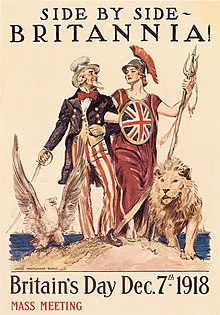
Back تجسيد وطني Arabic Nationalallegorie German Έθνος (προσωποποίηση) Greek Nacia personigo Esperanto Personificación nacional Spanish Pertsonifikazio nazional Basque شخصیتبخشی به ملیت Persian Kansakunnan henkilöitymä Finnish Figure allégorique nationale French Personificación nacional Galician


A national personification is an anthropomorphic personification of a state or the people(s) it inhabits. It may appear in political cartoons and propaganda.
Some personifications in the Western world often took the Latin name of the ancient Roman province. Examples of this type include Britannia, Germania, Hibernia, Hispania, Helvetia and Polonia.
Examples of personifications of the Goddess of Liberty include Marianne, the Statue of Liberty (Liberty Enlightening the World), and many examples of United States coinage. Another ancient model was Roma, a female deity who personified the city of Rome and his dominion over the territories of the Roman Empire.[1]
Examples of representations of the everyman or citizenry in addition to the nation itself are Deutscher Michel, John Bull and Uncle Sam.[2]
- ^ "Il Tempio di Venere e Roma" (in Italian). Retrieved 12 September 2023.
- ^ Eric Hobsbawm, "Mass-Producing Traditions: Europe, 1870-1914," in Eric Hobsbawm and Terence Ranger, eds., The Invention of Tradition (Cambridge, 1983), 263-307.
© MMXXIII Rich X Search. We shall prevail. All rights reserved. Rich X Search